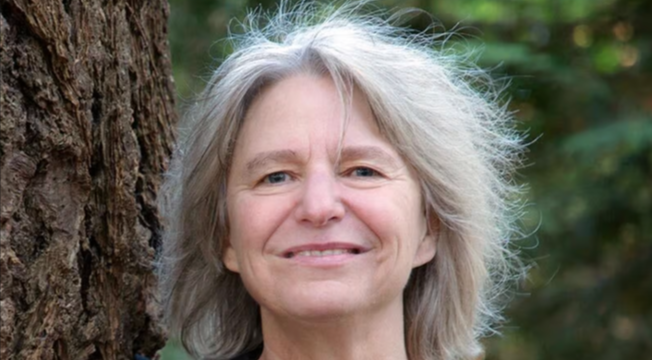Exploring Forest Wisdom: A Conversation with Dr. Suzanne Simard

The following conversation was part of the Resilience and Possibility series. To access the recording, please scroll to the bottom of this post.
On June 27th, the global Pachamama Alliance community came together with Dr. Suzanne Simard for a conversation on the interconnectivity of forest ecosystems and what we can learn from the mysterious ways plants communicate.
Dr. Simard is a renowned forest ecologist, author, and professor who has dedicated her life to exploring the intricacies and underground networks of forests. A pioneer in plant communication and intelligence, she is perhaps best known for her groundbreaking research on Mother Trees and how trees use underground fungal networks to interact with each other.
Dr. Simard's journey into her research on forest ecology and the communication between trees began with her upbringing in the rainforests of British Columbia, where she developed a strong connection to the land and a deep understanding of the interconnectedness of the forests.
What We Can Learn From the Wisdom and Intelligence of Forests
When asked about her work uncovering the wisdom and intelligence of forests, Dr. Simard shared several key learnings.
She began by describing the existence of fungal networks in soil, called mycorrhizal associations, which are essential for the health of trees and forests. These networks connect trees and plants below ground, allowing for the exchange of nutrients and water. Dr. Simard went on to explain that big, older trees—what she calls Mother Trees—play a nurturing role in forests. These Mother Trees provide resources to support the growth of young seedlings, giving preferential assistance to their own offspring. This demonstrates kinship within the forest, where older trees have responsibilities as elders and sources of wisdom.
As Dr. Simard pointed out, these principles of balance, kinship, and reciprocity reflect the teachings of many Indigenous cultures.
Dr. Simard went on to explain that the term "Mother Tree" has been used in many different cultures for a long time, and she adopted this term to convey some of the scientific findings she has made.
In her research, she and her team had mapped the underground networks in forests, studying the connections between trees of different ages and sizes. They found that mycorrhizal networks connect the trees together, with the biggest and oldest trees being the most highly connected. These large trees act as hubs in the forest, with extensive root systems and photosynthetic crowns that transfer resources, such as sugars, through the mycorrhizal networks to younger trees. The concept of Mother Trees emphasizes the importance of these large trees in the interconnectedness within and the regenerative capacity of forests.
The Importance of Indigenous Sovereignty and Land Rights
Dr. Simard also discussed the connection between her work and the teachings of Indigenous peoples, emphasizing the need to move away from exploitative resource extraction and toward a caring and responsible approach to nature’s life support systems. Dr. Simard stressed the significance of Indigenous knowledge in caring for different ecosystems and adapting to climate change, as many Indigenous peoples possess in-depth, place-based knowledge of the land, its plants, animals, and how to tend to them.
Dr. Simard emphasized the importance of supporting Indigenous sovereignty and rights as a crucial aspect of protecting and restoring ecosystems. She highlighted how land is deeply connected to culture and life for many Indigenous communities, and when land is taken away or damaged, it disrupts that vital connection. She was clear in her support of the rematriation of land to Indigenous peoples so that they can care for and tend to the land based on their ancestral knowledge.
How to Get Involved in Protecting Forests
When asked about how people can get involved in this work to protect forests and support Indigenous sovereignty and land rematriation, Dr. Simard had several suggestions.
She first recommended that individuals advocate for policy changes by clearly communicating the need to halt or pause destructive practices such as logging old-growth forests to local and federal politicians. She also emphasized the importance of supporting frontline organizations and communities. One way to do so is by providing financial support to organizations and individuals who are actively working to protect and restore forests and Indigenous rights.
Dr. Simard went on to highlight the importance of sharing accurate information and being an advocate for change when confronted with practices that harm forests or infringe upon Indigenous rights. She invited listeners to call out misleading narratives and help educate others about the true value of forests and the role of Indigenous communities in stewarding the land. She underscored how crucial it is to be brave and proactive in advocating for a more sustainable and equitable future.
Why Recognizing the Interconnectedness of All Life is Essential
Later in the call, Dr. Simard emphasized the need to view trees and forests as our relations. As she explained, recognizing the interconnectedness of all beings and understanding that different species have their own unique intelligence and role in the ecosystem is essential. She encouraged the reconfiguring of our worldview to one that respects and values all creatures, acknowledging that humans have the capacity to heal the damage that we have done and a responsibility to do so.
In closing, Dr. Simard spoke to the importance of supporting movements dedicated to healing and protecting the Earth. She encouraged everyone to spread awareness, teach others about the significance of these movements, and support them with good intention and heart, as we are all interconnected and dependent on the well-being of the planet.